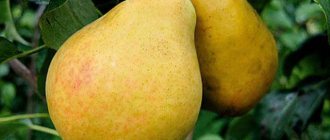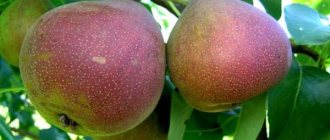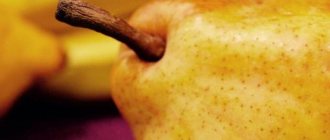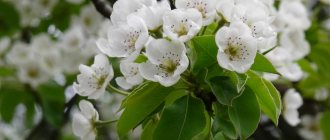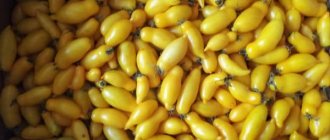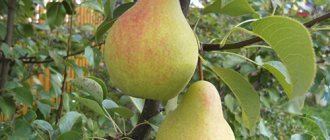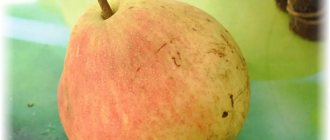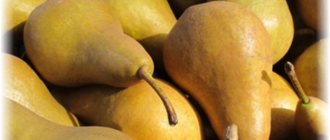Honey Pear.
Description of the variety
Honey pear is a representative of late autumn varieties. It is early-growing, productive and with distinctive fruit.
Characteristics of wood
The tree is small in size, its growth usually does not reach 2 meters. The crown is oval, medium dense, grows freely. The tree takes root well and is resistant to all influences.
Description of fruits
Honey Pear.
The fruits of Honey are the real advantage of the variety. Their size is larger than large, up to 500 grams. The skin is yellow-green, with a slight brownish blush. The shape of the fruit is regular pear-shaped, but the surface is lumpy and with small ribs.
The taste qualities on the pear tasting scale ranged from 4.7 to 5 points, according to various sources. The pulp is juicy, aromatic, slightly oily. It contains a large amount of sugars and beneficial elements.
Harvest and storage
The fruits of this variety can be harvested at the stage of technical maturity or fully ripe. In any case, the fruits are firmly attached to the stalks and are not prone to shedding.
If you put the harvested crop in the refrigerator and store it at a temperature of 0+1ºС, the fruit can be preserved until the New Year.
Before storing, you should not wipe the fruit to remove wax deposits - it helps preserve the fruit.
They also place the harvested crop in a dry, cool cellar, wrapping each fruit in paper and placing it in wooden boxes in one layer. In this case, the harvested crop can be stored for up to 60 days.
The main value of the Honey pear variety is the excellent taste of ripe fruits, which have a pleasant aroma and simply melt in your mouth. Therefore, this variety has been popular among Russian gardeners for several decades.
Advantages and disadvantages
The pear has a large number of significant advantages, for which it has become widespread among gardeners in the middle zone and southern regions.
Pros:
- large fruits;
- taste qualities of pears;
- high immunity;
- frost resistance;
- compact size of the tree;
- precociousness.
Minuses:
- the need for crop regulation;
- deterioration of stability when overloaded.
Honey columnar
Honey columnar is a type of honey pear. A straight trunk up to two meters long looks like a slender column. The branches are pressed to the trunk, the tree is extremely compact. Yellow oval fruits can reach 400 g in weight. The orange blush of the skin is followed by a sweet flesh that melts on the tongue. Given the neat shape of pear trees, they can be planted at a distance of 1 meter from each other.
The ripening times for this species are different: late summer, autumn, early winter. Pears can be grown in central Russia, in the Moscow region, and in the North Caucasus.
Forms and subspecies
Based on the Honey pear variety, several columnar-shaped subspecies were bred. They develop strong immunity to infectious and viral diseases, but have slightly lower frost resistance.
- G-1. A resistant winter variety with fruits of about 300 grams.
- G-2. Autumn pears are especially sweet and aromatic.
- G-3. Early autumn variety with large fruits.
- G-4. Resistant autumn variety.
- G-5. Summer look with fragrant pears.
Pollinators
This pear variety is partially self-pollinating, but in order to get a good harvest every year, you need to plant a couple of pollinating trees on your plot. In addition, you should choose pollinators that will bloom and ripen at the same time as the Honey variety. When purchasing seedlings, you need to choose 1-2 year old ones, as they will be able to adapt to the soil faster. But also in the third year of growth, they will begin the reproductive phase.
Cross-pollination with Tauride, Miraculous, Bere Bosc or Bere Ardanpont will allow you to get a larger harvest.
Reviews
It has only been growing on my site for 6 years. During this time we harvested twice. The pears are large, even very large, with a slightly ribbed shape. They taste exactly like honey, very sweet.
Igor
Donetsk
The tree is very small, which is what I like best. I have been growing a pear in the corner of my plot in the sun for quite a long time, there have been no problems in growing it.
Margarita
Rostov region
The pears are simply huge, but they don’t have a very regular shape with ribs. The color of the skin is yellow, almost transparent, they seem to be very fragile, but in fact they lie perfectly.
Alexey Viktorovich
Crimea
Honey pear is delicious
Pears can be eaten fresh and used for salty and sweet dishes and desserts. Try unusual combinations in salty dishes:
- In a salad with vegetables, pear will add freshness and add sweetness and sourness at the same time. The combination with beets is perfect.
- Pear perfectly complements the taste of soft cheeses.
- If you peel a pear so that a small child can enjoy the juicy pulp, do not throw away the skin and seeds. Place them in the stew. The sauce will become thick; no need to add flour.
- For dessert, it is an indispensable component for fruit salads. Pairs perfectly with cardamom, cinnamon, mint.
- In muffins and pies, the pear is friends with any nuts and behaves well alone.
- Oatmeal crumble with honey pear will become a favorite breakfast for the whole family.
Landing
The key to proper development and long fruiting is the correct planting of the Honey pear variety. There are certain requirements regarding its location on the site, the correct choice of planting dates and adherence to technology. You can read about everything in more detail in the linked articles.
How to plant a pear tree correctly
At what distance to plant pears?
How to choose pear seedlings
How to replant a pear
Features of growing crops
You can plant a pear in your garden plot. First you need to buy a 1-2 year old seedling from the nursery.
Disembarkation dates
The tree can be planted in early spring (April) - before the buds open, or in the fall (September-October) - a month before the arrival of frost. In regions with cool winters, autumn planting is practiced. In cold climate zones, it is better to plant pears in spring. After all, if a planted tree does not have time to take root before the onset of frost, it will die. For spring planting, preparatory work is carried out in the fall. For autumn, on the contrary, in spring.
Selection of location
The pear tree does not tolerate transplantation; it is recommended to immediately plant the tree in a permanent place. An area well lit by the sun and protected from the cold north wind is suitable. It is undesirable to plant a tree in a swampy area, as severe waterlogging will cause the roots to rot.
Care
The pear is unpretentious, so caring for the Honey variety will not be difficult. This includes proper watering, pruning and shaping, proper fertilization and winter preparation. More details about all these requirements of an agricultural technician can be read by following the link to the articles on our portal below.
How to care for a pear Pruning a pear Pruning a columnar pear Treating a pear from diseases and pests Feeding a pear How to water a pear
Winter-hardy pear varieties for growing in the Moscow region
Since the climate in the Moscow region is quite harsh with low temperatures during the winter, not all pear varieties will be able to grow normally in this region; their shoots and fruit buds may freeze. But there are a large number of varieties of this fruit tree that have been bred with high resistance to cold, so they can easily grow not only in the Moscow region, but also in more northern regions.
Frost-resistant pear variety "Lada"
This self-fertile, early-ripening variety has excellent winter hardiness - it can withstand frosts down to -30-32 degrees without shelter.
Celsius, and the crown quickly recovers after freezing. The harvest time is the first or second ten days of August. But ripe fruits are stored for no more than 12-15 days.
Frost-resistant pear "Cathedral"
This variety is characterized by early fruiting, so it begins to bear fruit already 4 seasons after planting the seedlings in a permanent place. Fruiting is stable, annual, yield is high. The variety is not susceptible to most diseases, including scab, and is highly resistant to frost. Although the Cathedral pear is self-fertile, if Lada or Pamyati Zhegalov varieties are planted nearby, its yield increases by about 1/3.
Chizhovskaya
This variety is one of the best in terms of frost resistance, therefore it is the most popular for cultivation in the northern regions of Russia. The Chizhovskaya pear is distinguished by its early ripening, resistance to scab, and large fruit - the weight of ripe fruits can reach 250-280 g.
Diseases and pests
Most pear diseases avoid the Honey variety. But during mass epidemics, pears can be affected by scab, rust and fruit rot. Pests almost never appear on the tree. You can read about how to prevent and protect against diseases and pests of the Honey pear by following the links to the articles below.
Dangerous Pear Pests
Pears often suffer from pests, they affect the leaves, bark and fruits.
In this article, we have selected 11 of the most harmful insects that harm pear trees, and also ways to destroy them.
Diseases of pear trees
To get what they cherish, gardeners have to work hard, and the reason for this is pear diseases.
Read about 19 common pear diseases and how to combat them.
Description of the plant, characteristics of pollination and fruiting
A compact tree about 2 m high, with a crown of a classic pyramidal shape, of medium density. The branches extending from the central conductor are directed upward. The bark on the trunk is dark gray, on the branches it is lighter. The foliage is dark green with a glossy sheen. The leaves are medium sized, oval in shape with a short pointed tip and finely serrated edge. The leaf blade has noticeable venation and is slightly concave along the central axis. Petiole of medium length.
The buds are collected in clusters of 5-7 pieces
Flowering is abundant and long lasting in May and practically does not suffer from return frosts. The flowers are medium-sized, cup-shaped, and have five petals. The petals are white, sometimes with a pinkish tint.
The variety is partially self-fertile and the presence of pollinators has a positive effect on yield. The best companions for it are the pears “Bere Bosk”, “Chudesnitsa”, “Tavricheskaya” and “Bere Ardanpon”.
Ovaries are formed on ringlets and fruit twigs. Fruiting begins from the fourth to fifth year after planting, in trees on a dwarf rootstock - from the third. The yield is stable, annual, almost independent of climatic and weather factors, averaging from 15 to 30-35 kg per tree. When the fruits reach technical ripeness, they are firmly held on the branches and therefore require manual picking.
The compact dimensions of the tree make harvesting much easier
The harvest is usually harvested in the second ten days of September. It tolerates transportation well; it can remain in the fruit storage for two months, and in a refrigerator - 200-210 days, maintaining marketability at 92.7%.

